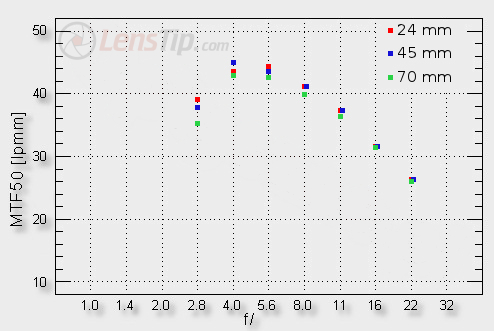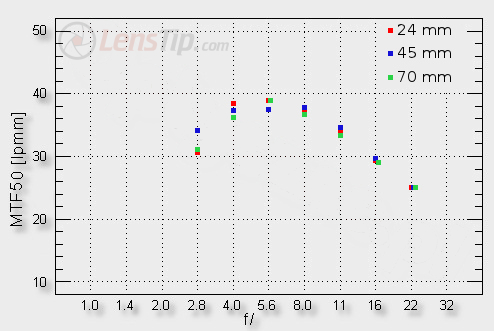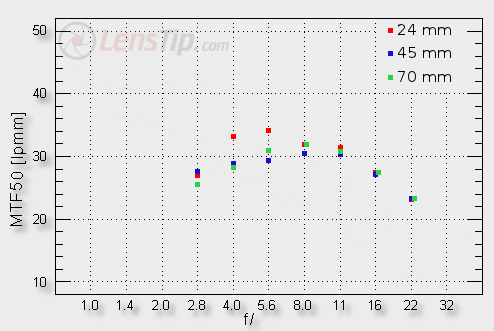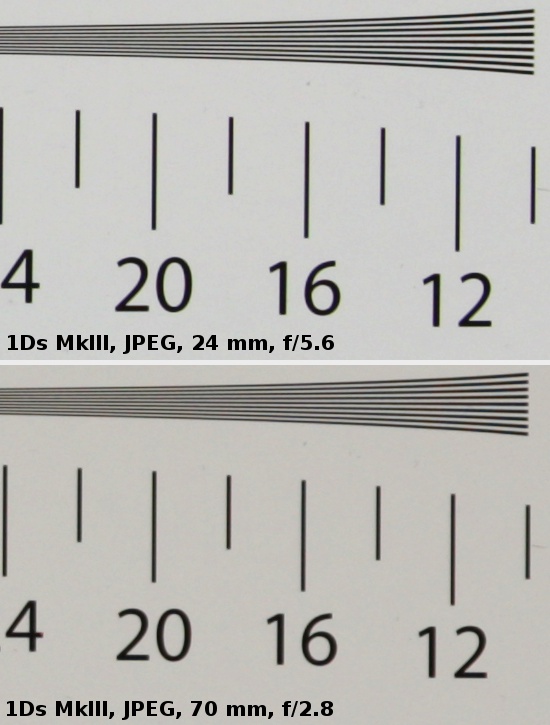Canon EF 24-70 mm f/2.8L II USM
4. Image resolution
First let’s check how the tested lens fares in the frame centre.

Please Support UsIf you enjoy our reviews and articles, and you want us to continue our work please, support our website by donating through PayPal. The funds are going to be used for paying our editorial team, renting servers, and equipping our testing studio; only that way we will be able to continue providing you interesting content for free. |
- - - - - - - - - - - - - - - - - - - - - - - - - - - - - - - - - - - - - - - - - - - - - - - -
We get here results you would like to admire as often as possible. The lens is sharp already from the maximum relative aperture and on stopping down to f/4.0-5.6 it generates images of truly excellent quality. What’s more, its work is very even – the values you get at 24 mm and 45 mm are practically undistinguishable. The 70 mm focal length lags behind a bit but in its case we noticed a distinct difference between particular testing charts. The achievements of the lens got worse and worse while passing to shorter focus distance. In typical working conditions at 70 mm the lens is situated more or less as far from the photographed object as it was from the biggest testing chart in our studio, where its results were the best. We present average results on our graph so if you take into account only these for bigger distances, the values at 70 mm will be more or less the same as those at shorter focal lengths.
It is interesting how other 24-70 mm lenses compare here. The predecessor is noticeably worse practically at all combinations of apertures and focal lengths. The Nikkor 24-70 mm, although its performance is not so even, fares a bit better, especially near the maximum relative aperture and across the whole 24 mm focal length, where its results were simply record-breaking. The Canon is distinctly better than the Tamron 24-70 mm VC and just a tad better than the Sigma 24-70 mm.
How does it fare on the edge of the APS-C/DX sensor. Let’s consult a graph below.

Here the tested lens deserves to be only praised. The images are fully useful already from the maximum relative aperture at every focal length. On stopping down their quality is very good and here the order is reversed: the new Canon is better than the Nikkor, which had problems with being fully useful by f/2.8. The Sigma 24-70 mm loses to the Canon at the maximum relative aperture as well but it reacts much better on stopping down and from f/4.0-5.6 it improves a lot and prevails. Of course the edge of full frame is always the most demanding place.
Let’s check how the tested Canon 24-70 mm f/2.8 II fares there.

The situation is not so rosy anymore. At the maximum relative aperture the results are situated below 30 lpmm so in order to get a useful image the lens must be stopped down near f/4.0-5.6. You should add, though, that the rivals don’t perform here well either. The combination of good fastness, an all-purpose focal range and a demanding detector makes itself felt.
The summary of this chapter cannot be other than positive. The lens gets great results in the frame centre, very good on the edge of the APS-C/DX sensor and decent on the edge of full frame. It is practically sharper than its predecessor everywhere and it compares favourably with its competitors. The analysis concerning the exorbitant price/ very high quality ratio will be done in the final summary chapter.
At the end of this chapter we presents some crops taken from photos of our testing chart. These were saved as JPEG files along with RAW files, used for the analysis above.
 |






